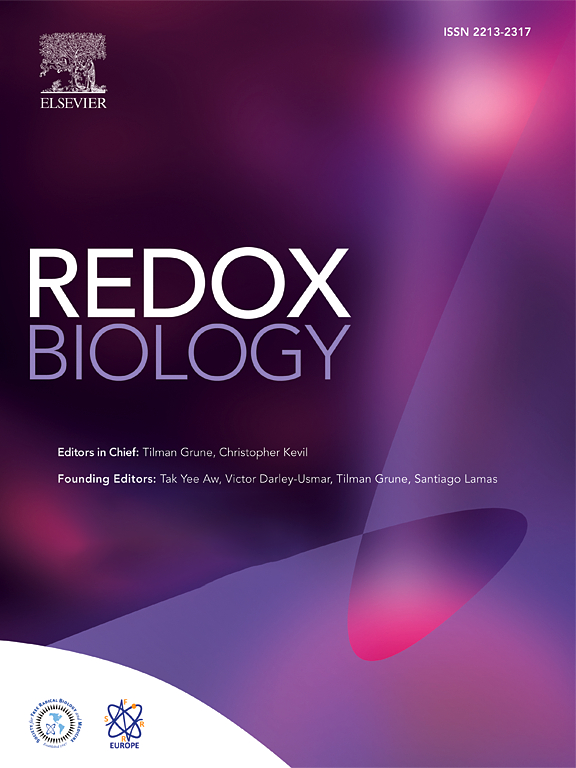独立于keap1的Nrf2调控:治疗肾脏疾病的新靶点
IF 10.7
1区 生物学
Q1 BIOCHEMISTRY & MOLECULAR BIOLOGY
引用次数: 0
摘要
转录因子nf - e2相关因子2 (Nrf2)是哺乳动物抗氧化反应的主要调节因子,在解毒、维持细胞稳态、对抗炎症和纤维化以及减缓疾病进展方面起着关键作用。Kelch-like ECH-associated protein 1 (Keap1)是Cullin 3-based E3泛素连接酶的一个接头亚基,是氧化和亲电应激的关键传感器,通过将Nrf2隔离在细胞质中来调节其活性,导致其蛋白酶体降解和转录抑制。然而,靶向keap1依赖性Nrf2调控通路的临床潜力有限。Keap1基因敲除小鼠的早期产后死亡,以及在人类Alport综合征患者、2型糖尿病和慢性肾脏疾病患者中Keap1药物阻断后的显著不良事件证明了这一点。确切的潜在机制尚不清楚,但可能涉及损伤和正常组织中Nrf2抗氧化反应的非特异性和全身性激活。除了依赖keap1的调控外,Nrf2活性还受keap1不依赖的机制调节,包括转录、表观遗传和翻译后修饰。特别是,GSK3β已成为这些不同信号通路的关键会聚点。与keap1依赖性调节不同,gsk3 β介导的keap1非依赖性Nrf2调节不影响Nrf2的基础活性,但在细胞应激的延迟/晚期调节其反应。这使得Nrf2反应的诱导性、强度和持续时间可以进行微调,特别是在应激或损伤组织中。肾脏是人体代谢最活跃的器官之一,是活性氧和活性氮产生的主要来源,也是易受氧化损伤的器官。靶向gsk3 β介导的Nrf2调控途径是治疗肾脏疾病的一种有希望的新方法。本文章由计算机程序翻译,如有差异,请以英文原文为准。
Keap1-independent Nrf2 regulation: A novel therapeutic target for treating kidney disease
The transcription factor NF-E2-related factor 2 (Nrf2) is a master regulator of antioxidant responses in mammals, where it plays a critical role in detoxification, maintaining cellular homeostasis, combating inflammation and fibrosis, and slowing disease progression. Kelch-like ECH-associated protein 1 (Keap1), an adaptor subunit of Cullin 3-based E3 ubiquitin ligase, serves as a critical sensor of oxidative and electrophilic stress, regulating Nrf2 activity by sequestering it in the cytoplasm, leading to its proteasomal degradation and transcriptional repression. However, the clinical potential of targeting the Keap1-dependent Nrf2 regulatory pathway has been limited. This is evidenced by early postnatal lethality in Keap1 knockout mice, as well as significant adverse events after pharmacological blockade of Keap1 in human patients with Alport syndrome as well as in those with type 2 diabetes mellitus and chronic kidney disease. The exact underlying mechanisms remain elusive, but may involve non-specific and systemic activation of the Nrf2 antioxidant response in both injured and normal tissues. Beyond Keap1-dependent regulation, Nrf2 activity is modulated by Keap1-independent mechanisms, including transcriptional, epigenetic, and post-translational modifications. In particular, GSK3β has emerged as a critical convergence point for these diverse signaling pathways. Unlike Keap1-dependent regulation, GSK3β-mediated Keap1-independent Nrf2 regulation does not affect basal Nrf2 activity but modulates its response at a delayed/late phase of cellular stress. This allows fine-tuning of the inducibility, magnitude, and duration of the Nrf2 response specifically in stressed or injured tissues. As one of the most metabolically active organs, the kidney is a major source of production of reactive oxygen and nitrogen species and also a vulnerable organ to oxidative damage. Targeting the GSK3β-mediated Nrf2 regulatory pathway represents a promising new approach for the treatment of kidney disease.
求助全文
通过发布文献求助,成功后即可免费获取论文全文。
去求助
来源期刊

Redox Biology
BIOCHEMISTRY & MOLECULAR BIOLOGY-
CiteScore
19.90
自引率
3.50%
发文量
318
审稿时长
25 days
期刊介绍:
Redox Biology is the official journal of the Society for Redox Biology and Medicine and the Society for Free Radical Research-Europe. It is also affiliated with the International Society for Free Radical Research (SFRRI). This journal serves as a platform for publishing pioneering research, innovative methods, and comprehensive review articles in the field of redox biology, encompassing both health and disease.
Redox Biology welcomes various forms of contributions, including research articles (short or full communications), methods, mini-reviews, and commentaries. Through its diverse range of published content, Redox Biology aims to foster advancements and insights in the understanding of redox biology and its implications.
 求助内容:
求助内容: 应助结果提醒方式:
应助结果提醒方式:


